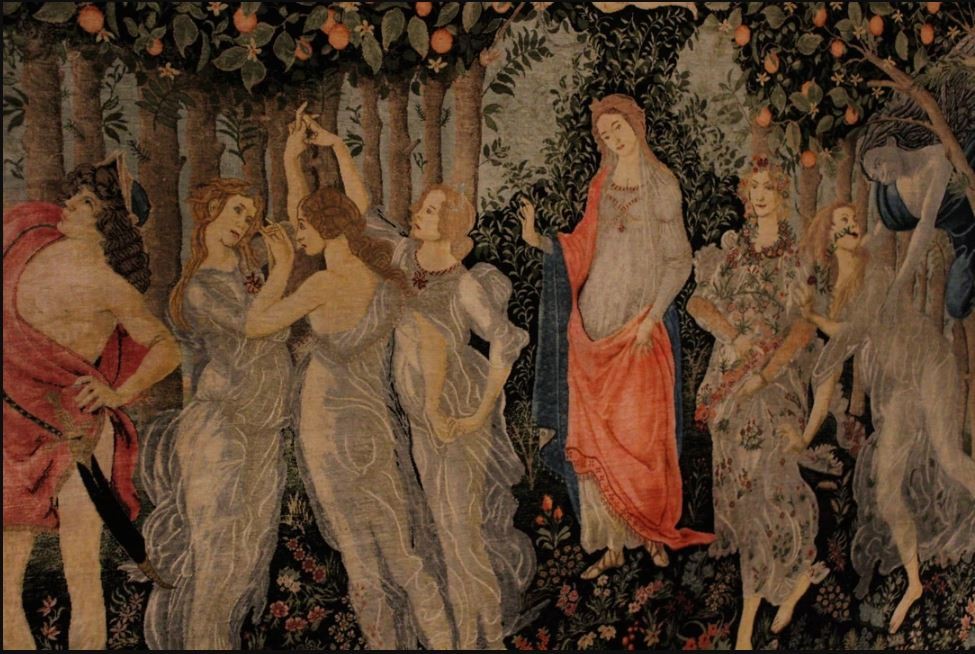Central Anatolia Region Kayseri Natural Bunyan Carpet
Turkmen Bukhara Hand-Woven Carpet
West Anatolia Denizli Baklava Rug
Central Anatolia Taspinar Hand-Woven Carpet
Central Anatolia Afyon Cicim Rug
Central Anatolia Konya Ladik Hand-Woven Carpet
Hand Woven Kazakh Rug
West Anatolia Antique Milas Hand Woven Carpet
Central Anatolia Konya Karapinar Cicim Rugs
West Anatolia Canakkale Ayvacik Hand Woven Carpet
Kazakh Sirvan Hand-Woven Carpet
Hand Woven Central Asian Kazakh Rug
Kayseri Bunyan Vintage Hand Woven Carpet
West Anatolia Balikesir Nomad Rug
Aegean Patchwork Hand Woven Rug
Patchwork from Anatolian Rugs TSH9857463569
East Anatolia Kars Rug
West Anatolia Denizli Cicim Rug
West Anatolia Oushak Esme Rug
West Anatolia Milas Carpet with Double Roses
Sandro Botticelli's "La Primavera"
Late 15th Century Florence
For 300 years, the Medici family, who ruled the Republic of Florence, made a great fortune in banking. They decided to allocate some of their wealth to art and science. Thus, the fuse of the Renaissance was lit.
With the support of the Medicis, many artists and scientists experienced their golden age during this period. Rafael, Michelangelo, Botticelli, Leonardo da Vinci, Galileo, to name a few.
Imagine; you could have come across all of these people, who have not been forgotten for 500 years due to their contributions to human history, on the streets of Florence in the late 1400s...
The Lorenzo de Medici period was the heyday of both the Renaissance and the Republic of Florence. This is why he was nicknamed "Lorenzo Magnifico" (Lorenzo the Magnificent) (like Solomon the Magnificent).
Lorenzo's cousin Pierfrancesco de Medici and Semiramide Appiani, daughter of the Lord of Lombardy, decided to marry. Lorenzo wanted to give his cousin a beautiful wedding gift and commissioned a painting by Sandro Botticelli, a close friend of his brother Giuliano.
This painting will decorate the bedroom of the Villa di Castello where they will live.

Botticelli, like other painters of the time, received support from the Medici family and was often a guest at the family's palace. Among the guests of the Medici family were not only painters but also important scientists of the time. For example Leonardo da Vinci, Galileo, Amerigo Vespucci...
Simonetta Vespucci, who was married to Amerigo Vespucci's cousin Marco, was one of the most beautiful women of the Renaissance. Simonetta, who frequently attends the invitations given by the Medici family, seduces two very close friends: Giuliano de Medici and Sandro Botticelli. Giuliano, who was assassinated at a young age, is rumored to have had an affair with Simonetta.
Botticelli, on the other hand, was very much in love with Simonetta. But he was never with her. Until he died.
Yes, Botticelli only found his love when he died. Because he willed to be buried at Simonetta's feet. When he died in 1510, 30 years after Simonetta's death, his will was fulfilled, and the great painter was buried at the feet of his great love. Today, in the Church of San Salvatore in Florence, his tomb is located at the feet of his love.
Simonetta, like all beautiful women, was unlucky. At the age of 23, she died of tuberculosis. Botticelli went into seclusion after her death and depicted her in many of his works. The female figures in The Birth of Venus and Primavera all evoke Simonetta.



